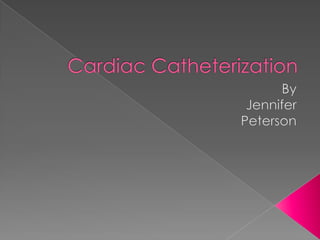
Cardiac catheterization
- 2. Cardiac catheterization views the anatomy of the heart using a contrast material injected into the coronary arteries under fluoroscopic imaging. Fig. 1
- 3. Assess the severity Data collection and extent of coronary artery disease (CAD) Cardiomyopathies Valvular or myocardial disorders Determine CAD in patient with chest pain of unknown Genetic disorders origin
- 4. Uncontrolled Uncompensated hypertension congestive failure Severe anemia Active infection or Ventricular febrile illness fibrillations Electrolyte Acute stroke abnormalities GI bleeds Severe Allergy to contrast coagulopathy Renal failure
- 5. After patient is properly identified, the procedure must be explained before consent can be signed Baseline vital signs will be done and as long as these are within the doctor’s interest, can proceed with the procedure Blood tests must be done including BUN, creatnine, PTT, INR, insulin/sugar levels
- 6. After patient is put on table, the area being puncture must be free from hair Hair removal done by disposable electric razor and removed by sticky side of cloth tape Patient must be surgically cleaned with hospital approved sterile surgical prep solution
- 7. The technologist working with the cardiologist must be scrubbed in following basic sterile surgical technique The patient is then draped from neck down with sterile drapes All equipment (radiation shields, image intensifier, equipment used to manipulate machine) must be prepped with sterile covers
- 8. Procedure tray should include: -sterile gowns and gloves for scrub tech and doctor -sterile towels and drapes for procedure -equipment covers -gauze -scalpel, needles, scissors, hemostats -syringes for heparin/saline flush, lidocaine, and blood draw -labels with marking pen for any item filled with a solution -basin for heparin/saline mixture, basin for waste fluids, small cup for lidocaine -skin prep solution -high power manifold -connection tubing Fig. 2
- 9. Fig. 3 -Three catheters are used: JR4 (advances to right coronary arters, JL4 (advances to left coronary arteries), and 145 degree pigtail catheter (to advance into ventricles -One 135cm wire -Sheath corresponds with catheter size (5F cath gets 5F sheath etc.) -Size of catheter depends on doctor’s preference but generallly 6F is used
- 10. Patient relaxed with Versed or Fentanyl, sometimes both Two 500mL bags of saline infused with 2,000 units (2cc) heparin each for flushing all tubing, catheters, sheaths Lidocaine for tissue numbing Visipaque contrast unless otherwise specified
- 11. When doctor and tech are scrubbed and all equipment and supplies are ready, the procedure may begin
- 12. Access is easiest from right side of patient due to aortic bend Puncture is generally done via the femoral artery Alternative sites include the radial and brachial arteries of the arm
- 13. After puncture of femoral, radial or brachial artery (primarily on right side of patient), a catheter is advanced into the aorta and then the coronary arteries
- 14. After numbing the groin area, the femoral artery is palpated and a needle is inserted in that direction When blood comes out of needle, the artery has been accessed A small, flexible guidewire is then inserted into the lumen of the needle The needle can then be removed but the wire must maintain position
- 15. After removing the needle, a flexible plastic tube can be placed over the wire and introduced into the artery. This is called a one-way sheath (allows insertion of catheters and wires without blood escaping) The catheter is then inserted over the guidewire but through the sheet and advanced into placement via the inferior vena cava to the aorta
- 16. Movement of catheter is monitored under fluoroscopy (x-ray movies) with the cardiologist manipulating its movements The fluoroscopic machine is manipulated by a qualified, scrubbed in, radiologic technologist When catheter is in place, wire can be removed and contrast administered
- 17. Catheter in place to view left coronary arteries Catheter in place to view right coronary arteries
- 18. Pigtail catheter in left ventricle to measure ventricular pressure Aortagram used to assess ascending and descending aorta
- 19. Right coronaary arteries shown with contrast Left coronary arteries shown with contrast
- 20. The x-ray machine is suspended from the ceiling. It can be manipulated in multiple angles and views to achieve a desired picture. The x-ray comes from the bottom of the machine and the image intensifier that transmits the image is above the patient. Lead shielding and a radiation badge is required for all personnel in the room during the procedure.
- 21. The procedure is complete when the cardiologist has seen all the views and anatomy desired and all pressures recorded The catheter can be removed and manual pressure must be applied to entry site for 15 minutes
- 22. The patient must lie flat and supine for a minimum of two hours to ensure the artery does not reopen After two hours, the patient can be released to person driving the patient home Dressing must remain dry, no lifting over five pounds for three days No shower for 24 hours
- 23. No bathing or swimming for one to two weeks Drink plenty of fluids If severe pain, swelling or discoloration of limb occurs, doctor must be notified immediately
- 24. 1. Abdulla, Abdulla M. Cardiac Catheterization. Ed. Dr. Abdulla M. Abdulla. 18 February 2012. HeartSite. 24 Oct. 2012. http://www.heartsite.com/html/cardiac_c ath.html 2. Olade, Roger B. “Cardiac Catheterization of the Left Heart”. Medscape Reference. Ed.Karlheinz Peter. 10 Jan. 2012. Medscape Reference. 24 Oct. 2012. <http://emedicine.medscape.com/article/ 1819224-overview#aw2aab6b2b3>
- 25. Figure 1. Hale, Jane. Untitled. 2008. The Flint Journal. http://blog.mlive.com/flintjournal/newsnow/20 08/02/mclaren_opens_new_cardiac_cath.html Figure 2. AliMed. Medline Cardiac Catheterization Procedure Tray. Alimed. 24 Oct 2012. http://www.alimed.com/medline- cardiac-catheterization-procedure-tray.html Figure 3. Merit Medical. Performa Multipack Angiographic Cardiology Catheters. Merit Medical. 24 Oct 2012. http://www.merit.com/products/default.aspx? code=performamcath
Notes de l'éditeur
- Figures not listed here can be found in the previously referenced sites.